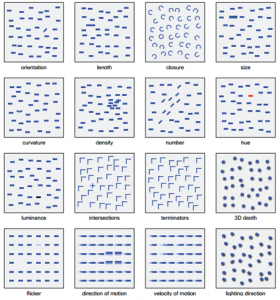Posts Tagged HCI(Human Computer Interaction)
User Interface Design: How to get human visual attention by Gemma Fitzsimmons
Posted by dingran in Academic Article on May 6, 2012
Introduction
This post will describe a number of basic effects in relation to human vision and attention, focusing on how those effects can be relevant to the design of web site displays.
Saliency
Saliency is all about how much something stands out. If an object is salient, then it is more likely to attract your attention.
However, if everything is salient, it is difficult to figure out what is important and the display could be confusing. You may have already noticed this with web pages that have too much clutter, making it hard to find what you are looking for [1].
Therefore, when designing the interface to a web-based application, the items which are the most salient need to be those that are the most important to the users (e.g., buttons which are used regularly or have useful information, such as notifications).
Grouping
When a number of similar objects are close to one another, they can be visually ‘grouped’ by the user. This is particularly easy when the objects are the same colour. When ‘grouped’, they are treated as a single unit, rather than lots of single units. This makes it easier to either ignore them, or pay attention to them when necessary [2].
In the case of our project we may wish to allow the user to group feeds from different social networks together. One way to achieve this would be to colour the items according to their source (e.g., colour the backgrounds to Facebook items one colour, Twitter items a different colour and so on). This will enable the users to easily distinguish the origin of the information.
Preattentive Processing
Attention has various components. Some of these are under conscious control; others are automatic. One automatic component of attentional processing is preattentive processing. This was first described in Treisman’s Feature Integration Theory [3]. Objects will ‘pop out’ when an item in the display is salient compared to the rest of the items in the display. Examples of the many different ways an item can pop out and be detected preattentively are listed below in the image. These features can attract the users attention just because they pop out compared to the rest of the display.
